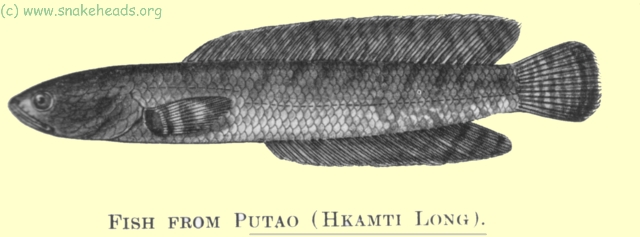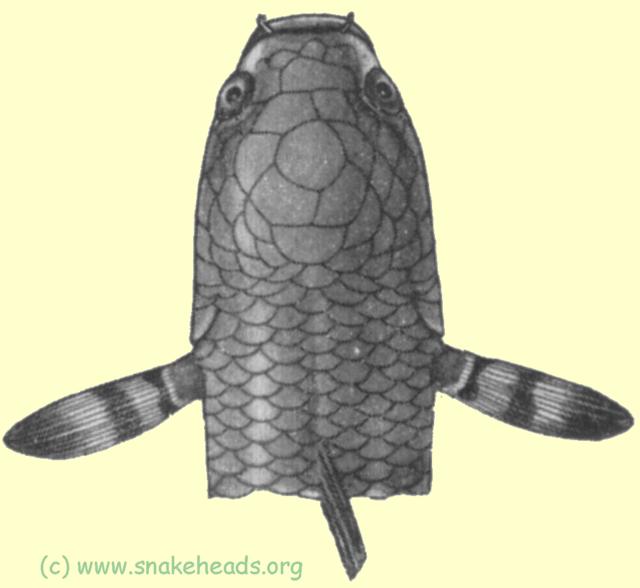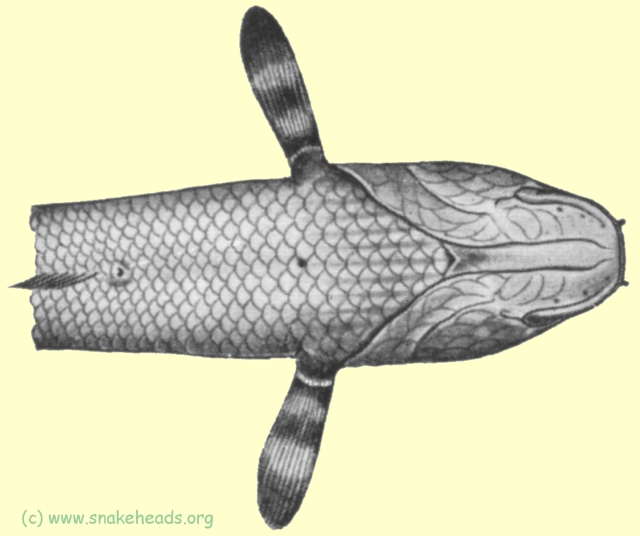
The fish described or discussed in this paper were recently collected by Dr. Murray Stuart of the Geological Survey of India. The collection though small and not including any specimens of large size is of considerable interest. No fish has hitherto been reported from the extreme northern corner of Burma, and several interesting new form, are represented, the most remarkable of which is an undescribed species of the genus Channa, which, though known from both Ceylon and China, has not hitherto been discovered in the eastern parts of the Indian Empire.
The twenty-one specimens examined belong to twelve species, which fall into eleven genera representing five different families. Except in three or four instances all the species, belonging to quite unrelated families, have developed some kind of adhesive or sucking apparatus - an interesting instance of convergence or plasticity in the formation of specialized organs of a similar nature in a restricted environment.
Suborder Percesoces. Family Ophicephalidae. Channa burmanica, Chaudhuri, sp. nov.
 | Drawing of C.burmanica. |
The body is round in front but is very much compressed behind the vent which is situated about the middle. The dorsal profile from the anterior root of the dorsal fin slopes gently to the snout. The ventral profile, which is more convex in the region of the lower jaw than the upper, continues parallel to the dorsal profile as far as the vent, behind which both profiles continue in a straight line but converge towards the caudal peduncle, about the middle of which there is a slight concavity in both.
The height of the body at the anterior end of the dorsal fin is contained six and a half times in the total length without the caudal fin, and the width at the same region six and one-fourth times; the height about the middle of the caudal peduncle is contained ten and a half times and the width at the same part twenty-six and a half times in the total length.
The head is wide and is greatly depressed; its length is contained nearly four times in the total length without the caudal fin. The depth at the occiput is eight times and the width of the head six and one-third times in the total length. The opening of the mouth continues behind the orbit; the length of the maxillary is contained ten and three-fifth times and the width of the mouth eight and five-sixth times in the total length. The eyes are placed far forward; the diameter of the orbit is equal to the length of the snout and is contained five and three-fifth times in the length of the head. The interorbital space is very flat and its width is twice as long as the length of the snout. There are two nasal tubes over the tip of the snout, slightly longer than half the diameter of the orbit. The gular plate is rather long and narrow, rounded in front and notched behind, its length being contained six and a half times in the total length and its breadth five times in the width of the head. Round the gular plate on the margin of the gill membranes, which continue close to the chin, there is a series of openings of mucuous glands, the largest of which is far forward and is directly under the chin. The surface of the posterior portion of the gular plate has slight corrugations which may possess some adhesive function; in places on it, as well as on the edge of the gill membrane round it, there are coriaceous patches which probably help the fish to stick against the force of the current.
There are fifteen scales in front of the dorsal fin (i.e. from the snout to the anterior end of that fin), and six scales between the hind margin of the orbit and the pre-opercle; there are the same number of scales between the last ray of the dorsal fin and the root of the caudal. The number of rays in the dorsal fin is thirty-eight, none of which are divided; the height of the longest ray (which is the seventh from the last) is contained eight times in the total length. The distance between the tip of the snout and the root of the pectoral fin is contained three and a half times in the total length, and the length of the pectoral fin five times. The latter has twelve flat rays. The anal fin commences one scale behind the vent and has twenty-eight undivided rays; the seventh ray from behind being the highest-nearly as high as the highest ray in the dorsal fin. The length of the caudal peduncle is equal to its height; there are nine scales between the last ray of the anal and the root of the caudal and eighteen scales round the caudal peduncle. The caudal fin is fan-shaped and consists of twelve rays; the middle rays are the longest; their length is contained nearly six times in the total length and they are just twice as long as the height of the root of the caudal fin.
 | Drawing of C.burmanica, top view. |
There are fifty-one scales in the lateral line of which fifty scales are perforated; the line bends down after twelve scales and then, with one unperforated scale intervening, continues to the root of the caudal with thirty-seven perforated scales. In the transverse series there are three rows of scales above the anterior twelve perforated scales and seven rows below this and above the mid-ventral line. In the posterior portion of the lateral line there are four transverse rows above and five and half rows below. There are twenty scales in the mid-ventral line between the posterior end of the gular plate and the vent.
| Body parts | Measurements in hundredths of total length without caudal fin |
| Depth of the body | 15 |
| Depth of caudal peduncle | 10.3 |
| Length of head | 26.4 |
| Depth of head | 13.2 |
| Width of head | 18.8 |
| Length of snout | 4.7 |
| Diameter of orbit | 4.7 |
| Width of interorbital space | 9.4 |
| Distance from tip of snout to anterior root of dorsal fin | 35 |
| Height of longest dorsal rays | 12.2 |
| Distance from tip of snout to root of pectoral fin | 28.3 |
| Length of pectoral fin | 17 |
| Distance from tip of snout to vent | 49 |
| Distance from tip of snout to anterior root of anal fin | 50.94 |
| Height of longest anal rays | 11.3 |
| Length of caudal peduncle | 10.38 |
| Width of caudal peduncle | 3.8 |
| Length of longest rays of caudal fin | 17 |
| Height of root of caudal fin | 8.5 |
| Total length without caudal fin in mm. | 106 |
The colour of the head and of the sides is dark brown; the ventral surface is dull white. In the young there are transversely oblique stripes of a deeper shade on the light brown or grey colour on the sides of the body. The pectoral fin is alternately variegated in bright white and black broad bands with an annular white zone round the black root of the fin; the caudal fin is alternately banded in white and black in their transverse stripes. There is no ocellus in the upper corner of the root of the caudal fin; the extreme ends of all the rays of the dorsal and anal fins are tipped with pure white.
 | Drawing of C.burmanica, dorsal view. |
This is the first time that any fish belonging to the genus Channa is reported from the Indian continent. The only species hitherto known from the Indian Region is Channa orientalis, Bloch and Schneider, which is found in Ceylon and China. Two other names in the same genus (C. ocellata, Peters1 and C. formosana , Jordan and Evermanns2 ) are in all probability synonyms of one another and priority decides for C. ocellata. Ophicephalus apus Canestrini3 , is in reality a Channa and differs very little from C. orientalis. Channa burmanica differs widely from these two hitherto known species in proportions, in the number of rays in the fins, in the arrangement and number of scales in the lateral line and other parts, as well as in colouration.
1 Peters, W.: Berichtete über einige neue Säugethiere ... Amphibien ... und Fische ... Monatsbericht der Königlich-Preussischen Akademie der Wissenschaften zu Berlin. Berlin 1864: 381-399. Today, it is considered to be a synonyme of Channa asiatica, Linne 1758. Back
2 Jordan, D. S., and B. W. Evermann: Notes on a collection of fishes from the island of Formosa. Proceedings. U.S. National Museum. 1902, vol. 25 (no. 1289). pp. 315-368. Today, it is considered to be a synonyme of Channa asiatica, Linne 1758. Back
3 Canestrini, G. Sopra una nuova specie di Ophiocephalus senza ventrali Ophiocephalus apus. Archivo per la zoologia, l'anatomia e la fisiologia. (Genova) v. 1 (no. 1). pp. 77-79. Today, it is considered to be a synonyme of Channa orientalis, Bloch and Schneider. Back
This text was originally published under the above title in: Records of the Indian Museum. 1919, vol. 16, part 4, pp. 271-287; plate 22.
© 2001 - 2002 snakeheads.org